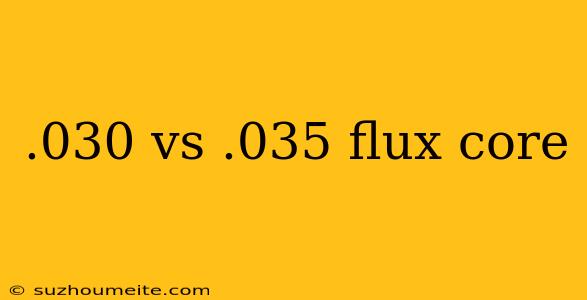.030 vs .035 Flux Core: What's the Difference?
When it comes to flux core welding, the size of the wire can make a significant difference in the quality of the weld. Two of the most common sizes used are .030 and .035 flux core wire. But what's the difference between them? In this article, we'll explore the advantages and disadvantages of each size to help you determine which one is best for your welding needs.
.030 Flux Core Wire
Advantages:
- Thinner wire, easier to feed: .030 wire is thinner and more flexible, making it easier to feed through the welding gun. This results in fewer tangles and kinks, allowing for a smoother welding process.
- Better for thinner materials: .030 wire is ideal for welding thinner materials, such as sheet metal, auto body panels, and small pipes. It produces a smaller, more concentrated weld pool, which reduces warping and distortion.
- Less heat input: The smaller wire diameter means less heat is generated during welding, making it suitable for welding heat-sensitive materials.
Disadvantages:
- Less penetration: .030 wire has less penetration power, making it less effective for welding thicker materials.
- Less weld deposit: The smaller wire diameter results in a smaller weld deposit, which may require more passes to achieve the desired weld size.
.035 Flux Core Wire
Advantages:
- More penetration power: .035 wire has more penetration power, making it suitable for welding thicker materials, such as heavy plate, large pipes, and structural steel.
- More weld deposit: The larger wire diameter results in a larger weld deposit, reducing the number of passes required to achieve the desired weld size.
- Faster welding speeds: .035 wire allows for faster welding speeds, increasing productivity and efficiency.
Disadvantages:
- Thicker wire, harder to feed: .035 wire is thicker and less flexible, making it more difficult to feed through the welding gun. This can result in more tangles and kinks, leading to a more challenging welding process.
- Not suitable for thin materials: .035 wire is not ideal for welding thin materials, as it can produce excessive heat, warping, and distortion.
When to Use Each Size
- Use .030 flux core wire for:
- Welding thin materials (sheet metal, auto body panels, small pipes)
- Welding heat-sensitive materials
- Applications requiring high precision and control
- Use .035 flux core wire for:
- Welding thicker materials (heavy plate, large pipes, structural steel)
- Applications requiring high productivity and efficiency
- Welding operations that require more penetration power
In conclusion, the choice between .030 and .035 flux core wire depends on the specific welding application, material thickness, and desired weld quality. By understanding the advantages and disadvantages of each size, you can make an informed decision and achieve the best results for your welding projects.
